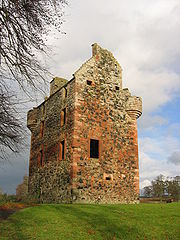
Greenknowe Tower
Encyclopedia

Tower house
A tower house is a particular type of stone structure, built for defensive purposes as well as habitation.-History:Tower houses began to appear in the Middle Ages, especially in mountain or limited access areas, in order to command and defend strategic points with reduced forces...
, located just west of the village of Gordon, in the Scottish Borders
Scottish Borders
The Scottish Borders is one of 32 local government council areas of Scotland. It is bordered by Dumfries and Galloway in the west, South Lanarkshire and West Lothian in the north west, City of Edinburgh, East Lothian, Midlothian to the north; and the non-metropolitan counties of Northumberland...
. Although a roofless ruin, the stonework of the tower is well preserved, and represents a fine example of a later tower house, built more as a residence rather than as a place of defence. The building is located at , beside the A6105 road. It is a Scheduled Ancient Monument
Scheduled Ancient Monument
In the United Kingdom, a scheduled monument is a 'nationally important' archaeological site or historic building, given protection against unauthorized change. The various pieces of legislation used for legally protecting heritage assets from damage and destruction are grouped under the term...
, and is in the care of Historic Scotland
Historic Scotland
Historic Scotland is an executive agency of the Scottish Government, responsible for historic monuments in Scotland.-Role:As its website states:...
.
History
The lands of Greenknowe were obtained by the Setons of Touch in the early 15th century, when Alexander Seton married a GordonClan Gordon
Clan Gordon, also known as the House of Gordon, is a Scottish clan. The chief of the clan was the powerful Earl of Huntly, now also Marquess of Huntly.-Origins:...
heiress. The tower was built in 1581 by James Seton, and the date, his initials, and the initials of his wife Janet Edmonstone, are inscribed above the door. The castle is situated on a low natural mound, which was originally surrounded and defended by marshy ground.
In the 17th century, the tower was sold to the Pringles of Stichil, who made additions to the building, and enlarged the windows to suit the less dangerous times. The castle was occupied until the mid 19th century, and passed into state care in 1937 following restoration works.
The tower

The tower is entered by a door in the re-entrant angle, which retains its original iron gate or yett
Yett
A yett is a gate or grille of latticed wrought iron bars used for defensive purposes in castles and tower houses...
. This gives access to a vaulted basement, originally divided into kitchen and cellar. The kitchen has a broad fireplace, slop drain and cupboard in the north wall, with a hatch overhead into the hall. Iron meat hooks remain in the ceiling.
Beneath the stair is a small chamber which accesses an east-facing gunloop. The broad turnpike stair leads up to the hall level, from which a smaller stair accesses the upper storeys. This stair is built into a corbelled turret in the re-entrant angle.
The hall occupies the first floor of the main block. There is a large fireplace in the east wall, and four large windows. Blocked doorways in the north walls of the hall and the stair once gave access to the north range, which was built in the 17th century but has since been demolished. Above the hall, the floors of the main block each had two rooms, with a further four rooms, one above the other, in the wing. All the rooms had fireplaces.
The walls are of rubble construction, using local basalt with red sansdtone for detailing, and finish at crowstep gables. Bartizan
Bartizan
A bartizan or guerite is an overhanging, wall-mounted turret projecting from the walls of medieval fortifications from the early 14th century up to the 16th century. They protect a warder and enable him to see around him...
s, or angle-turrets, are found at the north-west and south-east corners of the main block, and the south-east corner of the wing. The smaller wing bartizan also had machicolation
Machicolation
A machicolation is a floor opening between the supporting corbels of a battlement, through which stones, or other objects, could be dropped on attackers at the base of a defensive wall. The design was developed in the Middle Ages when the Norman crusaders returned. A machicolated battlement...
s.
The tower once had fine gardens laid out to the west, no trace of which remains. The foundation of an outbuilding lies to the north-east.

